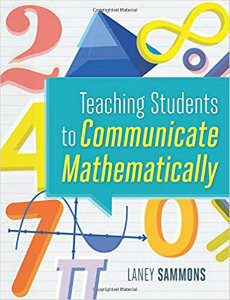Tools to Boost Students’ Math Communication
Teaching Students to Communicate Mathematically
By Laney Sammons
(ASCD, 2018 – Learn more)
 Reviewed by Beth Ferguson
Reviewed by Beth Ferguson
Communication is at the heart of teaching!
Our communicating clearly with our students and our students being able to communicate their new learning are both essential to the learning process. Laney Sammons’ book, Teaching Students to Communicate Mathematically, caught my eye. As a former math teacher and now a tutor, I want to develop students’ ability not just to manipulate numbers but to talk with understanding about the big ideas in mathematics.
 I enjoyed reading Sammons’ book. The structure of her writing appealed to me. She provides succinct research, offering background and clarity to her key points, and then jumps in with plenty of “how-to” ideas. The book is a great balance of why and how.
I enjoyed reading Sammons’ book. The structure of her writing appealed to me. She provides succinct research, offering background and clarity to her key points, and then jumps in with plenty of “how-to” ideas. The book is a great balance of why and how.
Spoken and written communication
In Teaching Students to Communicate Mathematically, the author identifies a common problem. Early on, she writes, “Too often…students receive little or no instruction on how to communicate about math effectively before they are asked to do so.” The book then sets out to provide educators the tools they need to teach students how to communicate mathematically, both conversationally and in writing.
I love that Sammons connects literacy strategies with communicating mathematically. So often we see math as being the stand-alone subject that doesn’t integrate well with others, and yet reading strategies like building vocabulary, inferring, predicting, summarizing, and generalizing are obviously embedded in our math lessons as well.
Specific tools to meet standards
The National Council of Teachers of Mathematics, the Common Core State Standards, and many individual state standards recognize the significance of teaching students how to organize their thoughts, present their findings clearly, and analyze conclusions in their peers’ work.
Sammons provides the tools to guide teachers’ planning to that end. The book doesn’t just say “teach communication.” It provides bulleted lists, charts, diagrams, examples of conversations and more to assist teachers in developing students who can talk coherently about their math learning.
Communication ideas I’ll focus on
There are many good ideas in Teaching Students to Communicate Mathematically. Let me share three that I want to focus on in my own work. The first is to “Provide authentic contexts for mathematical communication by students.” As the author points out, adults don’t engage in meaningless writing in real life. A question that I might pose with primary students could be why is it important to know the place value of numbers? Does it matter that the “4” in 142, 451 and 364 have different values?
For older students I might ask in what real world context is it important to understand the relationships between decimals, fractions, and percents? The conversations and writing that result from questions like these add to students’ conceptual understanding and help them relate the study of numbers to authentic contexts.
A second idea from Sammons’ book that I am incorporating in my work is her list of activities students need to practice as they learn to share their thinking. I’m reworking her list into a checklist for students — what I hope will be a helpful guide to writing a clear response to a mathematical question.
One last idea that I am incorporating right away in my work with students is Sammons’ chart on “Effective Queries and Comments that Foster Richer and Deeper Thinking.” I’m using her chart in my lesson planning so that I will be more intentional in building students’ communication skills.
I think you’ll find as I have that Teaching Students to Engage in Mathematical Conversations offers the support you need to engage math students in thinking and communicating deeply and more clearly.
Beth Ferguson is an educator with widely varied experience in schools. She had the privilege of serving students in positions as a classroom teacher, online instructor, and school principal. She was passionate about learning and found all of these positions challenging and satisfying. Since retiring, she has continued to follow her interests by volunteering in her grandsons’ classrooms and tutoring in her community. She periodically updates her blog, Algebra’s Friend, to provide resources to math teachers.


































We are beginning to use a Rubric for Mathematical Discourse in our district. I think communicating verbally first can aide in helping students to organize their thoughts before writing (and vice versa if students have difficulty sharing ideas or thoughts about a concept). I am interested in the effective queries and comments that foster richer and deeper thinking. Is there a free resource or site that anyone can recommend?